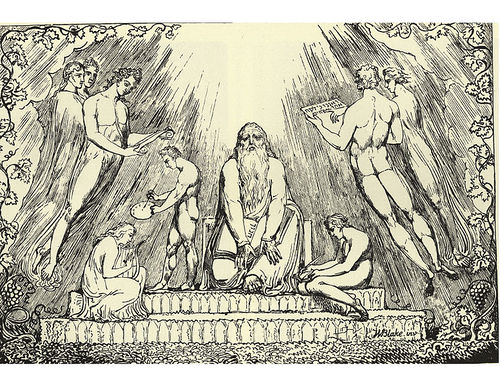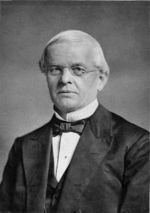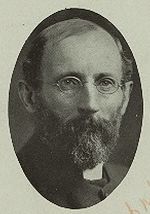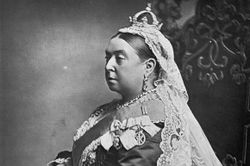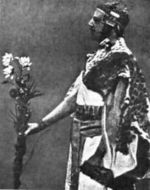Category:Enochic Studies--1850s
|
The page: Enochic Studies--1850s, includes (in chronological order) scholarly and literary works in the field of Enochic Studies, made in the second half of the 19th century, or from 1850 to 1859.
|
Enochic Studies : 2020s -- 2010s -- 2000s -- 1990s -- 1980s -- 1970s -- 1960s -- 1950s -- 1940s -- 1930s -- 1920s -- 1910s -- 1900s -- 1850s -- 1800s -- 1700s -- 1600s -- 1500s -- 1450s -- Home Timeline : 2020s -- 2010s -- 2000s -- 1990s -- 1980s -- 1970s -- 1960s -- 1950s -- 1940s -- 1930s -- 1920s -- 1910s -- 1900s -- 1850s -- 1800s -- 1700s -- 1600s -- 1500s -- 1450s -- Medieval -- Home
|
History of Research (1850s) -- Notes
In 1851 August Dillmann published the first eclectic edition of 1 Enoch based on 5 manuscripts, and in 1853 a German translation with commentary. The number of manuscripts of 1 Enoch available to Western scholars increased exponentially during the second half of the 19th century as the result of new expeditions in Ethiopia and acquisitions from antique dealers. By the end of the 19th century, copies of 1 Enoch were present in libraries in England, France, Germany, Italy and the United States. New translations appeared: in French (Gustave Brunet, 1856), English (George H. Schodde, 1882), Russian (Aleksandr V. Smirnov, 1888), and Hebrew (Lazarus Goldschmidt, 1892).
Increasingly divorced from the scholarly debate, esoteric speculations found new forms to survive and prosper, based on the claim that the Ethiopic book of Enoch was nothing more than a corrupted, forged and censored copy of the "true" wisdom of Enoch. In 1836 Anacalypsis by Godfrey Higgins had inaugurated what would be later called the new genre of “Fantastic Archaeology,” by collecting evidence to prove his assumptions about the existence of a primeval religion of humankind. In a similar fashion, in 1872 Edward Vaughan Hyde Kenealy related Enoch to the myth of Atlantis by making him king of Atlantis and the historical founder of universal wisdom.
Pseudo-science was not the only means of survival of Enochic esoteric traditions. In 1861 French occultist Alphonse Louis Constant (Eliphas Lévi) revived a neo-Christian-Kabbalist tradition, based on the works of Panteo and John Dee. Constant's work directly influenced the development in England of the system of Enochian Magic and the birth of the Hermetic Order of the Golden Dawn. The first initiations into the new Order took place at Mark Mason's Hall, London in March 1888. The Order dissolved in 1903 due to internal conflicts, but all contemporary forms of Enochian Magic have their roots in the experience of that group.
Free of the burden of esoteric speculations, Enochic scholarship flourished. August Dillmann published the first German translation (1850-51) and the first critical edition of the Ethiopic text (1859) of the Book of Jubilees, of which Antonio Maria Ceriani made available in 1861 also large portions of the old Latin version. The editio princeps of the Hebrew text of 3 Enoch in Lemberg in 1864, and the first critical edition of the Testaments of the Twelve Patriarchs by Robert Sinker in 1869 further advanced the scholarly knowledge of Enochic traditions. Major progress in the study of the text of 1 Enoch was also made thanks to the publication in 1892-93 of a new Greek fragment of the document (containing chs. 1-32). The ms (found in 1886-87 in Egypt) gave scholars not only a text larger than the one provided by the fragments of George Syncellus, but also a better understanding of the history of transmission of the text from the Semitic original to the Ethiopic. The English translation of 1 Enoch by Robert Henry Charles in 1893 was the first to use critically all this new material, thus opening a new stage in the history of research. Charles also published a new critical edition of the Book of Jubilees in 1895 and with W.R. Morfill the first English translation of 2 Enoch in 1896, making the Enochic traditions preserved in Slavonic available to specialists and the public in the West.
By the end of the 19th century the major writings attributed to Enoch (1 Enoch, 2 Enoch, 3 Enoch) or more closely related to Enoch (Book of Jubilees and Testaments of the Twelve Patriarchs) had been published and the emancipation of Enochic Studies from esoteric and magic concerns had been definitively accomplished. Contemporary Enochic scholarship was born.
@2014 Gabriele Boccaccini, University of Michigan
Pages in category "Enochic Studies--1850s"
The following 51 pages are in this category, out of 51 total.
1
- Die Offenbarungen Henoch's; oder, Das sogenannte Buch Henoch (1850 Clemens), book
- Das Buch der Jubiläen oder die kleine Genesis, aus dem Äthiopischen übersetzt (1850-51 Dillmann), essay
- Liber Henoch aethiopice (1851 Dillmann), book
- Notizen, Correspondenzen und Vermischtes: Ueber die Entstehungszeit des Buches Henoch (1852 Hofmann), essay
- Das Buch Henoch übersetzt und erklärt (1853 Dillmann), book
- Hebräische Quellen für das Buch Henoch (1853 Jellinek), essay
- Abhandlung über das äthiopische Buch Henókh (Treatise on the Ethiopian Book of Enoch / 1854 Ewald), book
- Ätiopischen Buches Henókh: Entstehung Sinn und Zusammensetzung (1854 Ewald), essay
- Enoch's Prophecy (1854 Greatheed / Montgomery), oratorio
- Ein Fragment des griechischen Henoch (1855 Gildemeister), essay
- Le livre d'Hénoch (1856-58 Brunet), essay
- Dictionnaire des Apocryphes (1856-1858 Migne), book
- Der jüdische Apokalyptic in ihre geschichtlichen Entwicklung (1857 Hilgenfeld), book
- Mashafa kufale sive Liber Jubilaeorum... aethiopice (1859 Dillmann), book
- Beiträge zur Erklärung des Buches Henoch nach dem äthiopischen Text (1860 Volkmar), essay
- La clef des grands mystères, suivant Hénoch, Abraham, Hermès Trismégiste, et Salomon (The Key to the Great Mysteries after Enoch, Abraham, Hermes Trismegistus, and Solomon / 1861 Constant), non-fiction
- Noch einige Bemerkungen zum Buch Henoch (1861 Dillmann), essay
- Sepher Hekhalot of R. Ishmael / 1864), book = ספר היכלות מהתנא רבי ישמעאל כהן גדול
- Ueber Henoch und Annakos (1866 Hitzig), essay
- De Apocryphi libri Henochi origine et argumento (1867 Sieffert), book
- Das Buch Henoch: sein Zeitalter und sein Verhältniss zum Judasbriefe (1868 Philippi), book
- Biblical Monograph: The Book of Enoch (1869 Cramer), essay
- Testamenta XII Patriarcharum (1869 Sinker), book
- Die 70 Hirten des Buches Henoch und ihre Deutungen (1870 Gebhardt), essay
- Enoch, the Second Messenger of God (1872 Kenealy), arch-fi
- De Apocalypse van Henoch en het Essenisme (1875 Tideman), essay
- The Book of Enoch (1882 Schodde), book
- Über den neugefundenen griechischen Text des Henoch-Buches (1883 Dillmann), essay
- Enoch's Gospel (Genesis v. 21-24; Hebrews xi. 5,6; Jude 14,15) (1884 Cox), essay
- Книга Еноха (The Book of Enoch / 1888 Smirnov), book
- The Calendar of Enoch and Jubilees (1891-92 Bacon), essay
- The Ethiopic Manuscripts of Enoch in the British Museum (1891 Charles), essay
- Pseudepigrapha (1891 Deane), book
- Die Apokryphen des Alten Testaments: nebst einem Anhang über die Pseudepigraphenliteratur (1891 Zöckler), book
- Fragments du texte grec du livre d'Énoch et de quelques écrits attribués à Saint Pierre (Fragments of the Greek Text of the Book of Enoch and Some Writings Attributed to St. Peter / 1892 Bouriant), book
- Fragments grecs du livre d'Hénoch (1892 Bouriant), essay
- Messianic Doctrine of the Book of Enoch and its Influence on the New Testament (1892 Charles), essay
- ספר חנוך / Das Buch Henoch (The Book of Enoch / 1892 Goldschmidt), book
- A Fragment of the Book of Enoch in Latin (1892 James), essay
- Le livre d'Hénoch: fragments grecs (1892 Lods), book
- Der griechische und der lateinische Henoch (1892 Zahn), essay
- The Book of Enoch (1893 Charles), book
- Mr. Charles's Edition of the Book of Enoch (1893 Cheyne), essay
- L'Évangile et l'Apocalypse de Pierre, avec le texte grec du livre d'Hénoch (1893 Lods), book
- Das slavische Henochbuch (1896 Bonwetsch), book
- The Book of the Secrets of Enoch (1896 Morfill/Charles), book
- The Slavonic Enoch (1897 Selbie), essay
- Eph. v. 14 and the Secrets of Enoch (1898 Nestle), essay
- The Psalms of Solomon: with the Greek Fragments of the Book of Enoch (1899 Swete), book
